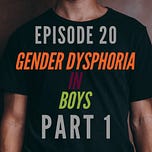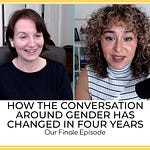Many presume that ROGD only impacts girls, but there is a significant number of boys who appear to show the hallmark traits of Rapid-Onset Gender Dysphoria. Not quite fitting in with Ray Blanchard’s classification of homosexual transsexualism or autogynephilia, these boys tend to be softly spoken Mommy’s boys, highly intelligent and hyper-ruminative. Many prefer to remain safe at home in their bedrooms and become fixated on medical transition. In this first of two episodes, Stella and Sasha introduce some of the different ways that gender dysphoria can manifest in boys.
Links:
Ray Blanchard (1989). “The classification and labeling of nonhomosexual gender dysphorias.” Archives of Sexual Behavior. 18 (4): 315–334. doi:10.1007/bf01541951. PMID 2673136. S2CID 43151898.
Blanchard R (August 2005). “Early history of the concept of autogynephilia.” Archives of Sexual Behavior. 34 (4):
439–446. CiteSeerX 10.1.1.667.7255. doi:10.1007/s10508-005-4343-8. PMID 16010466. S2CID
Michael Bailey (2003). The Man who would be Queen. Wikipedia.org/wiki/The_Man_Who_Would_Be_Queen
Anne Lawrence — (2013). Men Trapped in Men's Bodies: Narratives of Autogynephilic Transsexualism. Springer Science+Business Media. ISBN 978-1-4614-5181-5.
Angus Fox (2021) — “When Sons Become Daughters: Parents of Transitioning Boys Speak Out on Their Own Suffering” Quillette.com/author/angus-fox/
Donna M. (2021) — “You’re not trans, you’re just weird” Newdiscourses.com/2021/03/youre-not-trans-youre-just-weird/
Kellie Jay Keen Minshull — “The locker-room has a lot to answer for” Lesbianandgaynews.com/2021/02/kellie-jay-keen-the-locker-room-has-a-lot-to-answer-for
Transin’ the Suburbs — Ellen McEvoy
Counterweightsupport.com/2021/04/03/transin-the-suburbs/
Extended Notes
Boys and gender dysphoria; the conversations have been lacking when it comes to how, and why, they want to transition.
What do we currently know about transsexualism in males?
What is an autogynephilic transsexual?
What turns people on just turns them on. There’s very little we can do about changing that.
Erotic behavior becomes problematic when you force other people into participating without their consent.
Stella shares the different types of men who struggle with their gender.
Cartoon porn is terrifying because it distorts reality and it can influence a young person’s sexuality very deeply.
Wallflower children think it might be better to adopt a female persona. They think they’d get noticed more.
For males who are interested in female identity, they have more of a “performance” practice to their persona.
When an identity crisis occurs after a traumatic event, they spiral out of control trying to find meaning. Sometimes, becoming a girl is what makes the most sense.
Stella has noticed a lot of these males are very bright and intelligent people. Almost to a perfectionist quality and once they hit a ceiling or intellectual wall, they end up losing it and start questioning “who” they really are.
A lot of these men don’t want to be part of the privileged class. They want to be part of the solution.
Stella wonders if video games have something to do with this. She shares her thoughts.
If you find a boy who is struggling with gender, they often don’t want to talk about it. They just want to find a solution, which is often medical intervention.
When it comes to clothing, it’s so limited for boys. The girls have all the options!
For a lot of people, being able to name it, call it out, and talk about their gender dysphoria, has a lot of healing associated with it because they’re no longer in turmoil.
This podcast is partially sponsored by ReIME, Rethink Identity Medicine Ethics:
Learn more about our show: Linktr.ee/WiderLensPod











